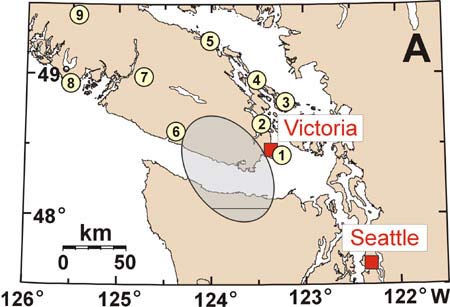Slow Seismic Slip Event Underway in Pacific Northwest

Updated 2:35 p.m. ET Sept. 14
An important seismic event imperceptible to humans has begun in the Pacific Northwest as predicted, according to the government agency Geological Survey of Canada.
The chance of a major earthquake is 30 times higher now for a roughly two-week period, but the odds are still remote, scientists say.
The event is called episodic tremor and slip (ETS). It involves a slow movement of the Juan de Fuca and North America tectonic plates along the Cascadia margin of southern British Columbia. Faults associated with the plates have been the sites of major earthquakes -- akin to the colossal tsumani-causing quake last December in Indonesia -- every 500 years or so, the geologic record shows. The last such temblor in the area struck on Jan. 26 in the year 1700.
Slow creep
The movement is slower than a traditional earthquake but more rapid than the normal creep associated with the fault. It runs in the reverse direction of the normal creep.
The movement was predicted. Scientists recently learned that these ETS events recur about every 14 months. It has been detected by Global Positioning System instruments.
Get the world’s most fascinating discoveries delivered straight to your inbox.
The event does not mean an earthquake is imminent, but geologists are eager to study it and learn more and they say sooner or later an ETS event is likely to trigger a major quake.
"Compared to the steady year-round stress accumulation, this more rapid stress increase implies that a large subduction earthquake is more likely to happen during the time of an ETS event," the Canadian geologists write.
The slippage and associated minor tremors "are directly related to megathrust (Sumatra-like) earthquake potential," lead geologist John Cassidy and a colleague said in Tuesday's statement. "Neither the tremor nor the slip can be felt."
Odds go up
The slip began Sept. 3 on the Olympic Peninsula of Washington State and has migrated north to the Vancouver Island area, Cassidy wrote. Victoria moved 0.12 inches (3 millimeters) to the West over the course of two days. The events are thought to last six to 15 days.
Cassidy's colleague, Stephane Mazzotti, has done some calculations on the odds of a large temblor.
"The probability of occurrence of a megathrust earthquake is about 30 times higher during this approximately two-week window, than during the rest of the 14.5 month cycle," Cassidy told LiveScience. "Having said that, 30 times a small number is still a small number."
Geologists simply don't know when one of these events will trigger a major quake, Cassidy said.
The immediate importance of the event is that it occurred as predicted and can now be used to improve understanding of the region's seismology.
"By better understanding these events, we will be able to better predict the effects (and perhaps timing) of future magnitude 9 earthquakes along the West Coast," Cassidy and his colleague write.
A separate study recently concluded that a major earthquake along the fault could be overdue, given clusters of the events seen in the geologic record. Because the fault is offshore, scientists say its rupture could create a devastating tsunami.
- Deadliest Earthquakes in History
- Central U.S. Warned of Larger Earthquakes to Come
- Tsunami-Generating Earthquake Near U.S. Possibly Imminent
- Potential Southern California Tsunami Could Cost up to $42 Billion
- U.S. Gulf Coast Faces High Tsunami Risk
Image Gallery
Deadly Earthquakes
Robert is an independent health and science journalist and writer based in Phoenix, Arizona. He is a former editor-in-chief of Live Science with over 20 years of experience as a reporter and editor. He has worked on websites such as Space.com and Tom's Guide, and is a contributor on Medium, covering how we age and how to optimize the mind and body through time. He has a journalism degree from Humboldt State University in California.




